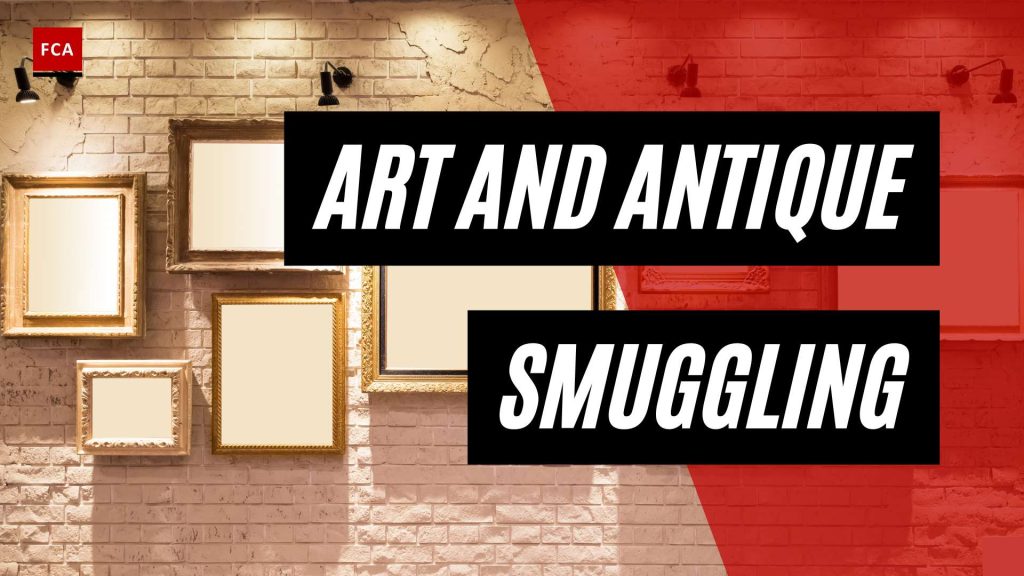Understanding Art and Antique Smuggling
Art and antique smuggling is a highly illegal activity that seeks to profit from stolen or illegally acquired works of art and artifacts. The illicit trade of cultural property not only deprives people of their history and culture but also weakens social cohesion, fuels organized crime, and contributes to the financing of terrorism (UNESCO). It is vital to understand the illicit trade of cultural property and the impacts it has on society.
The Illicit Trade of Cultural Property
The theft, looting, and illicit trafficking of cultural property are considered crimes that have far-reaching consequences. UNESCO, through the development of benchmark legal instruments like the 1970 Convention, aims to combat the illicit trafficking of cultural property and safeguard cultural heritage. The illicit trade of art and antiques contributes to the global black market for cultural heritage items (Department of Justice).
The underground art market plays a significant role in facilitating the illicit trade of art. Smugglers exploit various methods and channels to transport and sell stolen art and antiques, making it challenging for law enforcement agencies to combat this illegal trade (Department of Justice). The black market for antiques also thrives on the demand for valuable and rare artifacts, further perpetuating the illegal trade.
Impacts of Art and Antique Smuggling
The illicit trade of art and antiques has severe consequences on multiple fronts. Firstly, it poses a substantial threat to cultural heritage preservation. Stolen or illegally acquired artworks and artifacts are often irreplaceable, representing the history and identity of communities. The loss of these cultural treasures is a loss for humanity as a whole.
Secondly, art and antique smuggling undermines the integrity of the art market. The inclusion of illicitly obtained items in the legitimate market disrupts the fair and transparent functioning of the art trade. It erodes trust and confidence among buyers, sellers, and collectors.
Lastly, art and antique smuggling has broader implications for national security. The profits generated from the illicit trade can be used to finance criminal activities and even terrorism. By addressing the issue of art and antique smuggling, governments and law enforcement agencies can mitigate these risks and protect society as a whole.
To combat art and antique smuggling effectively, concerted efforts are required at the international level. Collaboration and cooperation among law enforcement agencies are crucial in identifying, investigating, and dismantling smuggling networks (Department of Justice). Additionally, implementing regulatory measures and raising awareness about the risks associated with the trade can help prevent the laundering of illicit funds through the art market.
By understanding the illicit trade of cultural property and its impacts, individuals and institutions can contribute to the preservation of cultural heritage and the integrity of the art market. Efforts to combat art and antique smuggling are necessary to protect our shared history and ensure a sustainable and lawful art trade.
Methods and Channels Used in Smuggling
Art and antique smuggling is a highly illegal activity that seeks to profit from stolen or illegally acquired works of art and artifacts. Smugglers employ various methods and channels to transport and sell these items, contributing to the global black market for cultural heritage. Understanding the techniques and strategies used in smuggling, as well as the existence of a global black market, is crucial in combating this illicit trade.
Smuggling Techniques and Strategies
Smugglers employ a range of techniques and strategies to evade detection and successfully transport stolen art and antiques across borders. Some common smuggling techniques include:
-
False Documentation: Smugglers may falsify documents, such as provenance records or export permits, to create the illusion of legitimacy for illicitly acquired artworks or artifacts. These false documents are used to deceive authorities and facilitate the movement of stolen items.
-
Hidden Compartments: Smugglers often use specially designed containers or vehicles with hidden compartments to conceal stolen art and antiques during transportation. These hidden compartments make it difficult for law enforcement agencies to detect the illicit items.
-
Mislabeling and Concealment: Smugglers may disguise stolen art and antiques as ordinary or innocuous objects to avoid suspicion. For example, valuable artworks may be concealed within furniture, packaging materials, or even innocuous items like toys or household goods.
-
Exploiting Legal Loopholes: Smugglers may exploit gaps in legal frameworks and regulations related to the trade and transportation of art and antiques. They may take advantage of differing laws and regulations across countries to facilitate the movement of illicit items.
Global Black Market for Cultural Heritage
The global black market for cultural heritage encompasses a vast network of illegal trade in stolen or illicitly acquired artworks and artifacts. This underground market provides a platform for smugglers to sell and profit from their illicit activities.
The black market operates through various channels, including:
-
Private Sales: Stolen art and antiques may be sold directly to private collectors or individuals who knowingly or unknowingly participate in the illicit trade. These private transactions often take place discreetly, making it challenging for authorities to track and intercept the flow of illicit items.
-
Online Platforms: The rise of the internet has facilitated the online trade of stolen art and antiques. Smugglers utilize various online marketplaces, social media platforms, and anonymous websites to connect with potential buyers and sell their illicit goods.
-
Corrupt Networks: Smugglers may exploit corrupt individuals within the art world, including gallery owners, art dealers, and auction house professionals, to facilitate the sale and transfer of stolen art and antiques. These individuals may assist in providing false provenance or ensuring the smooth movement of illicit items.
-
Transnational Criminal Organizations: Organized criminal networks play a significant role in the illicit trade of art and antiques. These networks have the resources and connections to transport stolen items across borders, utilizing various smuggling techniques and channels.
Combating art and antique smuggling requires international cooperation and the implementation of robust legal frameworks to disrupt the global black market. Efforts from law enforcement agencies, governments, and international organizations are crucial in investigating and prosecuting smuggling networks, as well as raising awareness about the importance of preserving cultural heritage and the risks associated with the illicit trade.
International Efforts to Combat Art and Antique Smuggling
To combat the illicit trade of art and antique smuggling, international cooperation and collaboration among law enforcement agencies play a crucial role. Recognizing the detrimental impact of this illegal activity on cultural heritage and society, efforts are being made to investigate and prosecute smuggling networks involved in this illicit trade.
Collaboration and Cooperation Among Law Enforcement Agencies
The fight against art and antique smuggling requires close collaboration and cooperation among law enforcement agencies at the international level. Recognizing the transnational nature of this crime, agencies from different countries work together to share information, intelligence, and expertise. Interpol, Europol, and other international organizations play a significant role in facilitating this cooperation.
Through platforms such as the Stolen Works of Art Database and the International Criminal Police Organization (Interpol) Works of Art unit, law enforcement agencies can exchange information about stolen artworks and identify potential smuggling networks. This collective effort enhances the chances of recovering stolen items and prosecuting those involved in the illegal trade.
Additionally, regional and bilateral agreements between countries help establish legal frameworks and channels for cooperation in combating art and antique smuggling. These agreements enable the sharing of best practices, joint investigations, and extradition of individuals involved in smuggling networks.
Investigating and Prosecuting Smuggling Networks
Investigating and dismantling smuggling networks involved in art and antique smuggling is a complex task that requires expertise and resources. Law enforcement agencies employ various techniques to gather evidence, track illicit transactions, and identify key players in these criminal networks.
Undercover operations, surveillance, and intelligence gathering are some of the methods used to gather evidence against individuals and organizations involved in art and antique smuggling. These investigations often involve collaboration between different law enforcement agencies, both domestically and internationally.
Once evidence is collected, prosecutors work towards bringing these smugglers to justice. Successful prosecutions not only result in the punishment of individuals involved in the illicit trade but also act as a deterrent for others considering engaging in such activities. By disrupting and dismantling smuggling networks, law enforcement agencies aim to significantly reduce the illegal trade in art and antiques.
Efforts to combat art and antique smuggling are ongoing, and international cooperation continues to evolve as new challenges arise. By working together and sharing resources, law enforcement agencies strive to protect cultural heritage, preserve the integrity of the art market, and prevent the financing of illicit activities.
In the next section, we will explore notable cases of art and antique smuggling, shedding light on specific instances where these illegal activities have been uncovered and addressed.
Notable Cases of Art and Antique Smuggling
Art and antique smuggling is a global issue that has drawn attention due to numerous high-profile cases. This section highlights two notable cases that shed light on the extent and impact of illicit trade in art and antiques.
The German Network of Illicit Antiquities
One significant case involved the discovery of a network of individuals engaged in the illegal trafficking of cultural objects, particularly antiquities. In January 2017, authorities in Germany uncovered a network of 15 individuals involved in the smuggling ring, which was based in Baden-Württemberg. The investigation revealed evidence of organized crime involvement and connections to the black market for looted cultural heritage items from conflict zones like Iraq and Syria.
This network was involved in the trafficking of nearly 5,000 objects, some of which were obtained from areas affected by armed conflicts (Artnet News). To combat the illicit activities of this network, coordinated raids were conducted by police and German prosecutors across three states, targeting the homes and businesses of the individuals involved in the smuggling ring.
Increase in Antiquities Trafficking During the Pandemic
The COVID-19 pandemic had unintended consequences for the illicit trade in art and antiques, with an increase in antiquities trafficking observed during this period. In 2020, illegal digging for antiquities in Egypt more than doubled, demonstrating a significant surge in looting activities during the pandemic (Al Jazeera).
Several factors contributed to this increase. First, the economic impact of the pandemic led to job losses, prompting some individuals to turn to illicit activities, including the looting and smuggling of cultural artifacts. Second, lockdown measures and reduced monitoring of archaeological sites and museums created an opportunity for illegal excavations to take place without sufficient oversight. Lastly, traffickers leveraged the digital economy, utilizing the dark web and popular social media platforms to sell looted antiquities (Al Jazeera).
The rise of online illicit trade in looted antiquities during the pandemic underscores the need for enhanced efforts to combat art and antique smuggling, both in physical and digital spaces. It highlights the importance of cooperation between law enforcement agencies, cultural heritage organizations, and online platforms to disrupt and prevent these illicit activities.
These notable cases exemplify the challenges faced in combating art and antique smuggling. Efforts to address this issue require international collaboration, increased regulation, and proactive measures to protect cultural heritage from being exploited for financial gain.
The Link Between Art and Antique Smuggling and Money Laundering
The world of art and antiquities has long been associated with prestige and high-value transactions. However, this allure also makes it vulnerable to exploitation by criminals seeking to launder illicit funds. The link between art and antique smuggling and money laundering is a concerning issue that requires attention.
Money Laundering Risks in the Art Market
The global art market has experienced significant growth in recent years, reaching a value of $579 billion in 2023, with the Asia-Pacific region being the largest single market (ComplyAdvantage). This growth, coupled with the lack of transparency and regulation in the art market, has created opportunities for money laundering schemes.
The underground art market provides a fertile ground for illicit activities. Criminals may use various techniques, such as over-invoicing or under-invoicing artwork, to manipulate prices and move funds across borders. The lack of a centralized registry or uniform reporting standards makes it difficult to trace the true ownership and value of artworks, facilitating the disguise of illicit funds.
Antiques, with their historical and cultural significance, are also vulnerable to money laundering schemes. The black market for antiques allows criminals to exploit gaps in regulation and exploit the high demand for rare and valuable artifacts. By using fraudulent provenance documentation or smuggling techniques, illicit funds can be integrated into the legitimate art and antique market.
Regulatory Measures to Combat Money Laundering
Recognizing the risks associated with money laundering through art and antiques, regulatory bodies and governments have taken steps to address the issue. The Anti-Money Laundering Act of 2020 in the US, for example, brought antiquities dealers under the same AML regulatory framework as financial institutions. This requires them to identify beneficial owners, maintain transaction records, and adopt compliance policies to combat money laundering in the art and antiquities market.
The Financial Action Task Force (FATF) has also made recommendations to tighten regulations in this area. The FATF’s 2016 Mutual Evaluation Report of Canada identified the luxury goods sector, including art and antiques, as having increased money laundering risks. This prompted recommendations to strengthen regulations and enhance due diligence measures within the country.
Internationally, the European Union has implemented directives to combat money laundering in the art market. The Fifth Anti-Money Laundering Directive (5AMLD) and the subsequent Sixth Anti-Money Laundering Directive (6AMLD) require art businesses within EU member states to establish risk-based programs, conduct due diligence, and report suspicious transactions.
In the UK, the Money Laundering Regulations Act has been amended to include provisions applicable to the art market. Entities involved in high-value art transactions are now required to register, implement AML procedures, provide training, report suspicions, and maintain records.
By implementing these regulatory measures, authorities aim to enhance transparency, due diligence, and reporting standards within the art and antique market. These measures play a crucial role in reducing the vulnerability of the market to money laundering activities and preserving the integrity of the financial system.
Understanding the link between art and antique smuggling and money laundering is essential for professionals working in compliance, risk management, anti-money laundering, and anti-financial crime. By staying informed and actively participating in efforts to combat money laundering in the art market, we can contribute to a more transparent, secure, and ethical art industry.
Combating Art and Antique Smuggling in Asia and Oceania
Art and antique smuggling remains a significant issue in Asia and Oceania, with the region serving as a final destination for many illicitly traded artworks and antiquities. The illegal trade of art and antiquities from Southeast Asia alone is estimated to be a multibillion-dollar industry, with a significant portion of these items eventually reaching markets in Asia and Oceania (Journal of Heritage Conservation).
The Illegal Trade of Art and Antiquities
The demand for art and antiquities in Asia and Oceania fuels the continuation of smuggling networks. Organized criminal networks play a crucial role in facilitating the illegal trade, operating across international borders and employing sophisticated techniques to smuggle these items (Journal of Heritage Conservation). Cambodia, in particular, has been a significant source country for looted antiquities, with many of these artifacts smuggled out of the country and eventually ending up in markets across Asia and Oceania.
To effectively combat the illegal trade of art and antiquities in Asia and Oceania, it is essential to address the root causes of the problem, including the demand for these items and the operations of organized criminal networks. Strengthening law enforcement efforts, enhancing international cooperation, and implementing stricter regulations are key steps in combating this illicit trade.
Organized Criminal Networks and Smuggling Techniques
Organized criminal networks involved in the smuggling of art and antiquities employ various strategies and techniques to evade detection and transport these items across borders. Some common smuggling techniques include:
- False Documentation: Criminal networks forge or alter paperwork, such as provenance documents, to give a false appearance of legitimacy to the illicitly traded artworks or antiquities.
- Mislabeling and Concealment: Smugglers often hide art and antiquities within legitimate shipments or conceal them in innocent-looking packages to avoid suspicion during transportation.
- Corruption and Bribery: Organized criminal networks may exploit corrupt officials or individuals within the art and antiquities trade to facilitate the smuggling process, allowing them to bypass customs and other regulatory procedures.
To effectively combat these smuggling techniques, law enforcement agencies in Asia and Oceania need to enhance their intelligence capabilities, strengthen border control measures, and collaborate closely with international counterparts. Sharing information and coordinating efforts can help disrupt the operations of these organized criminal networks and intercept illicitly traded art and antiquities before they reach their final destinations.
By addressing the illegal trade of art and antiquities in Asia and Oceania, countries can work towards preserving their cultural heritage, preventing the financing of illegal activities, and safeguarding the integrity of the art market in the region. It requires a concerted effort from governments, law enforcement agencies, and relevant stakeholders to combat this illicit trade and protect the invaluable cultural treasures of Asia and Oceania.
The Impact of Art and Antique Smuggling in Asia and Oceania
The illegal trade of art and antiquities in Asia and Oceania has significant ramifications, resulting in the loss of cultural heritage and financing of illegal activities. Additionally, it undermines the integrity of the art market in the region.
Loss of Cultural Heritage and Financing Illegal Activities
Asia and Oceania are rich in cultural heritage, with a diverse array of art and antiquities originating from these regions. However, the illegal trade of these items poses a serious threat to their preservation. It is estimated that the illegal trade of art and antiquities from Southeast Asia alone is a multibillion-dollar industry, with a significant portion of these items eventually reaching the markets in Asia and Oceania (Journal of Heritage Conservation). This illicit trafficking depletes the cultural heritage of countries of origin, stripping them of their historical and artistic treasures.
Furthermore, the proceeds from art and antique smuggling often contribute to the financing of illegal activities. Organized criminal networks play a key role in facilitating the smuggling of these items across international borders. These networks leverage sophisticated techniques and strategies to transport art and antiquities to markets in Asia and Oceania. The funds generated from these illicit activities can be used to fuel other criminal endeavors, such as drug trafficking, terrorism, and money laundering.
Undermining the Integrity of the Art Market
The illegal trade of art and antiquities in Asia and Oceania also undermines the integrity of the art market in the region. The demand for these illicit items in Asia and Oceania makes the region a final destination for art and antiquities that have been smuggled from their countries of origin. This perpetuates the continuation of smuggling networks and further fuels the illegal trade (Journal of Heritage Conservation).
The presence of illicitly traded art and antiquities in the market creates a distorted environment where genuine artworks and artifacts may be undervalued or overshadowed by fraudulent or looted pieces. This erodes trust and confidence in the art market, negatively impacting artists, collectors, and legitimate businesses. It also hinders efforts to promote cultural exchange and appreciation of authentic artworks.
To combat the impact of art and antique smuggling in Asia and Oceania, international cooperation, stringent regulations, and effective law enforcement efforts are crucial. Collaboration among law enforcement agencies, increased awareness, and the implementation of measures to prevent the illicit trade of art and antiquities are essential to safeguard cultural heritage and maintain the integrity of the art market in the region.








